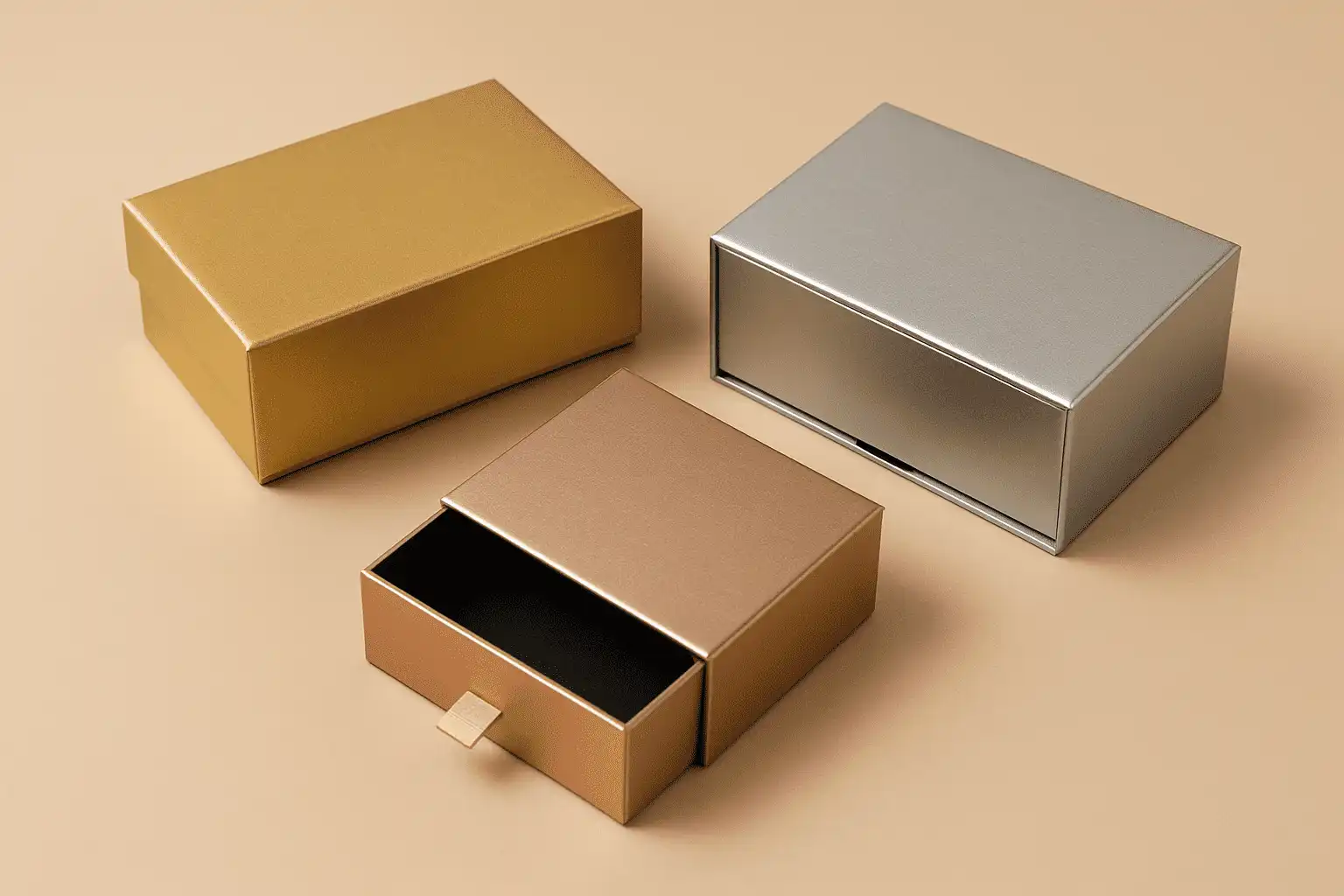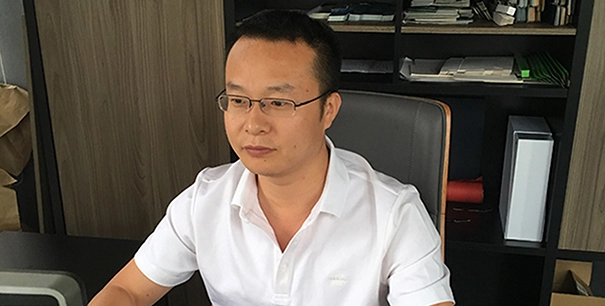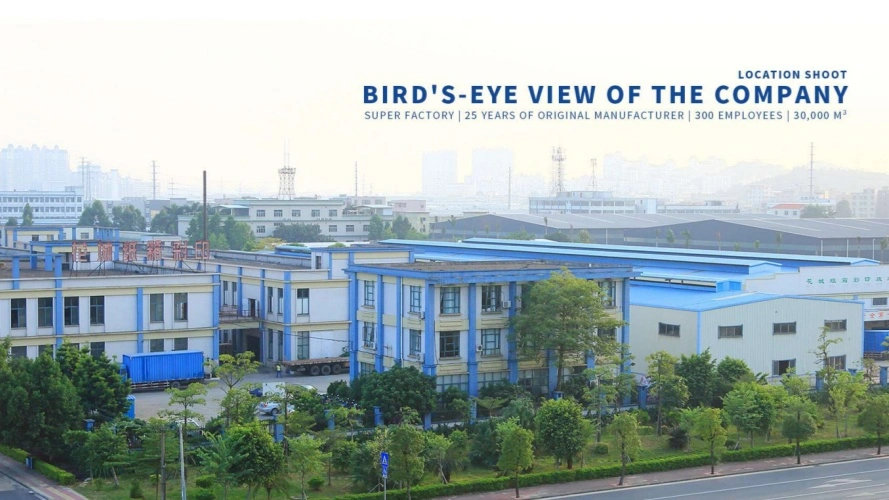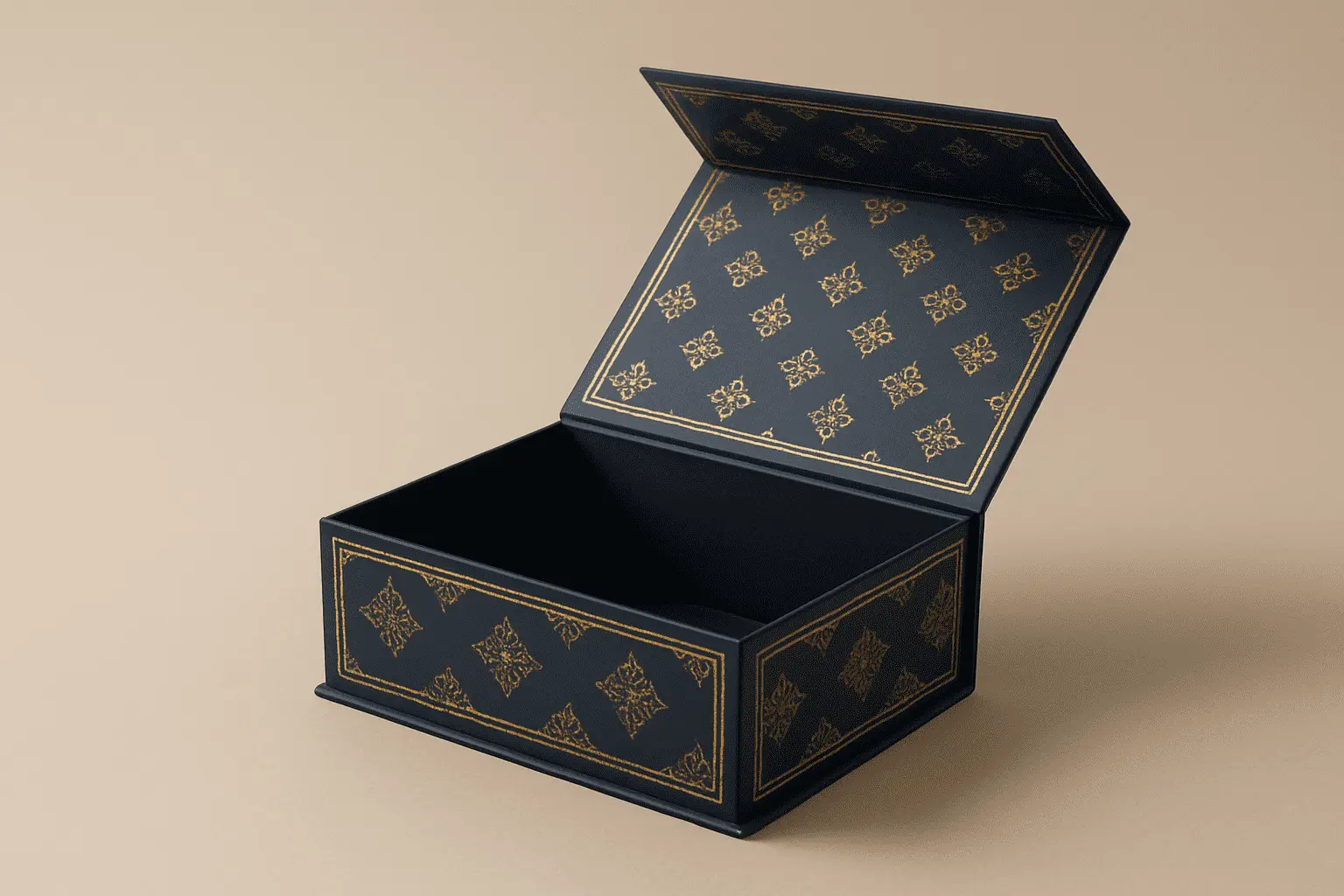Top 3 Metallic Paper Box Suppliers for Premium Gift Packaging
When luxury brands struggle to find packaging that truly reflects their premium positioning, the wrong metallic paper box supplier can undermine years of brand building. Today's discerning consumers expect more than ordinary packaging—they demand an unboxing experience that delivers visual impact, tactile sophistication, and environmental responsibility. This comprehensive guide reveals the top three metallic paper box suppliers who consistently deliver exceptional quality, innovative finishing techniques, and reliable production capabilities for premium gift packaging applications across cosmetics, electronics, and high-end retail sectors.

Understanding Metallic Paper Box Manufacturing Excellence
Premium metallic paper box production requires far more than standard printing capabilities. The manufacturing process demands specialized equipment, advanced material knowledge, and rigorous quality control systems to achieve the lustrous finishes and structural integrity that luxury brands require. Leading suppliers distinguish themselves through investments in cutting-edge machinery, comprehensive certification portfolios, and deep expertise in surface finishing techniques that transform ordinary paperboard into extraordinary packaging experiences.
The foundation of superior metallic paper box manufacturing begins with substrate selection. Premium suppliers offer multiple paperboard options including SBS C1S and SBS C2S materials in various thicknesses ranging from 250 grams to 400 grams per square meter, allowing brands to select materials precisely matched to their usage scenarios. SBS C1S features coating on one side for exceptional printability while maintaining uncoated reverse surfaces ideal for adhesive bonding, whereas SBS C2S provides brilliant white surfaces on both sides for dual-surface printing applications. These virgin bleached pulp substrates deliver the brightness, stiffness, and surface smoothness essential for achieving flawless metallic finishes through hot stamping, cold foil application, and specialty coating processes.
Critical Production Capabilities for Metallic Finishes
Achieving museum-quality metallic effects on paper box surfaces requires sophisticated production equipment and technical mastery. Advanced suppliers operate German-engineered Heidelberg printing presses capable of handling oversized sheets up to 1.62 meters in width, eliminating size constraints that plague smaller manufacturers and enabling seamless large-format designs without visible seams or registration issues. The printing phase employs both CMYK offset printing for photographic image reproduction and Pantone Matching System formulations for precise brand color matching, establishing the foundation for subsequent metallic enhancement.
Surface finishing represents where ordinary metallic paper box production diverges from exceptional manufacturing. Premium suppliers offer comprehensive finishing capabilities including hot foil stamping that transfers metallic films through heat and pressure, cold foil application utilizing UV-curable adhesives for intricate patterns, spot UV coating for dimensional contrast, soft-touch lamination creating velvety tactile experiences, and embossing or debossing techniques adding sculptural depth. These finishing options can be layered and combined—for instance, registering embossed patterns with metallic foil stamping creates striking dimensional effects impossible to achieve through single-process applications. The metallic paper box emerges from this multi-stage finishing gauntlet with surface characteristics that command attention on retail shelves and justify premium price positioning.
Material Sustainability and Certification Standards
Environmental responsibility has evolved from optional consideration to mandatory requirement for premium packaging suppliers. Leading metallic paper box manufacturers maintain FSC certification verifying their paperboard sources from responsibly managed forests, ensuring traceability throughout the supply chain. Beyond forest certification, comprehensive suppliers demonstrate commitment through ISO14001 Environmental Management System certification, establishing documented processes for waste reduction, energy efficiency, and continuous environmental improvement.
The metallic finishes themselves present sustainability considerations that separate responsible suppliers from shortsighted manufacturers. Water-based coatings offer eco-friendly alternatives to solvent-based systems, while recyclable lamination films and foils ensure finished metallic paper box products can enter circular economy waste streams. Brown kraft paperboard options manufactured from unbleached pulp provide brands seeking natural aesthetic appeals with sustainable substrate alternatives featuring inherent tear resistance and authentic texture. Forward-thinking suppliers actively invest in developing and validating new sustainable materials including bio-based coatings and compostable lamination films that maintain the visual impact luxury brands demand while minimizing environmental footprint.
Supplier #1: GUANGZHOU FETCHING COLOR PRINTING & PACKAGING LTD.
Established in 1999, GUANGZHOU FETCHING COLOR PRINTING & PACKAGING LTD. represents a quarter-century of continuous innovation in premium metallic paper box manufacturing. The company's 50,000-square-meter production facility employs over 300 skilled workers across integrated departments spanning prepress engineering, offset printing, surface finishing, die-cutting, and manual assembly. This vertically integrated manufacturing approach enables FETCHING to maintain rigorous quality control throughout every production stage while offering clients comprehensive packaging solutions from initial concept development through final delivery.
FETCHING's machinery inventory reflects strategic investment in industry-leading equipment designed specifically for luxury packaging applications. The facility operates KBA106 nine-color plus coating UV printing presses alongside Heidelberg XL162-6L large-format presses, providing flexibility for both high-volume production runs and specialized short-run projects. A dedicated 2.5-layer corrugated board production line enables manufacturing of protective shipping containers for delicate metallic paper box products, while five-color flexographic printing equipment handles high-speed carton production. Perhaps most significantly, an AI-enhanced gift box production line incorporates automated quality inspection and precision assembly capabilities that maintain consistent output quality across massive production volumes.
Comprehensive R&D and Engineering Support
FETCHING distinguishes itself through substantial investment in research and development capabilities rarely found among contract packaging manufacturers. The company's R&D department comprises more than ten packaging engineers with extensive professional experience spanning material science, structural engineering, and graphic design disciplines. These specialists provide invaluable consultation services including new material application recommendations, packaging structure development for challenging product geometries, artwork design optimization for manufacturing efficiency, and process technology selection ensuring specified visual effects achieve realization within budget constraints.
This engineering depth proves particularly valuable when brands require innovative metallic paper box solutions beyond standard catalog offerings. FETCHING's engineers routinely develop custom die-cutting patterns, design proprietary closure mechanisms, and specify multi-substrate lamination structures that balance aesthetic requirements against functional performance criteria. For luxury brands entering new product categories or launching limited-edition releases, this collaborative engineering approach accelerates development timelines while mitigating technical risks that could derail launch schedules or compromise perceived quality.
Quality Certifications and Manufacturing Standards
FETCHING's certification portfolio demonstrates commitment to internationally recognized quality and compliance standards. The company maintains ISO9001 Quality Management System certification verifying documented procedures govern all manufacturing processes, alongside ISO14001 Environmental Management System certification establishing environmental responsibility protocols. SMETA social compliance auditing confirms ethical labor practices throughout the organization, while G7 Color Management certification validates color reproduction accuracy meeting graphic arts industry standards. FSC forest stewardship certification ensures paperboard substrates originate from responsibly managed sources, and Disney supplier authorization confirms the facility meets entertainment industry requirements for product safety and ethical manufacturing.
This comprehensive certification framework provides brands with confidence that their metallic paper box products will meet regulatory requirements across global markets while aligning with corporate social responsibility commitments. The certifications also facilitate smoother customs clearance and reduce downstream compliance verification burdens for international clients. Perhaps most importantly, the rigorous audit processes underlying these certifications ensure consistent manufacturing quality regardless of production volume or order timing—a critical consideration for brands managing seasonal demand fluctuations or coordinating multi-market product launches.
Specialized Manufacturing Capabilities
FETCHING maintains several specialized capabilities that address common pain points in premium metallic paper box production. A dedicated manual assembly department staffed by 100 experienced craftspeople handles intricate gift box constructions requiring hand-finishing operations impossible to fully automate. This manual capability prevents packaging homogeneity by enabling unique structural features, hand-applied embellishments, and artisanal finishing touches that distinguish brands in crowded luxury segments. The department routinely executes complex assemblies including magnetic closure installations, ribbon tying, tissue paper insertion, and precision component positioning that automated equipment cannot reliably accomplish.
FETCHING's fifteen fully automatic die-cutting machines spanning various format sizes ensure efficient production scheduling and rapid turnaround times. This die-cutting capacity enables the facility to simultaneously process multiple client orders without bottlenecks, while format variety accommodates everything from compact cosmetic boxes through large-format electronics packaging. The die-cutting equipment handles both straight-line cutting for folding carton styles and intricate window cutting for product visibility features. Combined with in-house tooling fabrication capabilities, FETCHING can rapidly prototype new metallic paper box designs and transition approved samples into full production without external vendor dependencies causing delays.
Streamlined Ordering and Production Process
FETCHING implements a transparent four-stage ordering process designed to minimize confusion and establish clear expectations. The process initiates with demand consultation where clients articulate requirements via email inquiry, followed by solution design during which business managers conduct detailed content discussions addressing specifications, timeline constraints, and budget parameters. Professional implementation follows with sample production according to client requirements and detail confirmation ensuring alignment before committing production resources. Order placement concludes the process after client approval, with deposit payment triggering production scheduling.
The production workflow itself follows systematic stages beginning with printing operations transferring designs onto selected paperboard substrates using offset, digital, or flexographic presses depending on order specifications. Surface finishing follows with coating and varnish applications enhancing and protecting printed surfaces through techniques including UV curing, matte finishing, and gloss coating. Lamination operations bond printed sheets to sturdier substrates or apply protective films for enhanced durability. Die-cutting employs custom metal dies cutting precise shapes, creating windows, and trimming edges exactly to specification. Gluing and assembly operations fold and bond die-cut components forming finished boxes. Final packing and shipping stages prepare completed metallic paper box products for dispatch, with careful attention to protective packaging preventing damage during logistics handling.
Supplier #2: International Premium Packaging Manufacturers
Beyond GUANGZHOU FETCHING, several additional suppliers deserve consideration when sourcing metallic paper box solutions for premium gift packaging applications. International manufacturers operating throughout Asia, Europe, and North America each bring distinct advantages depending on brand requirements, geographic considerations, and specialization needs. Evaluating multiple qualified suppliers enables brands to identify optimal partnerships based on specific project parameters rather than defaulting to single-source relationships that may not align with every packaging initiative.
Specialized Metallic Finishing Expertise
Certain suppliers have developed particular expertise in advanced metallic finishing techniques that create distinctive visual effects. Cold foil stamping specialists utilize UV-curable adhesive systems enabling intricate metallic patterns impossible through conventional hot stamping, while holographic finishing experts create multi-dimensional optical effects through specialized film laminates. Suppliers focusing on combination finishing techniques can register multiple processes—such as embossing within metallic foil areas or applying spot UV coatings over metallic substrates—achieving layered dimensional effects that dramatically enhance perceived value.
When selecting suppliers based on finishing capabilities, brands should request physical samples demonstrating specific techniques under consideration rather than relying solely on photographic representations. Metallic finishes possess tactile and optical characteristics that cannot be accurately conveyed through digital images, and physical evaluation reveals important details including foil adhesion quality, pattern resolution, and viewing angle effects. Leading suppliers maintain extensive sample libraries showcasing their finishing capabilities across various substrate types, enabling informed comparisons and specification decisions.
Geographic and Logistics Considerations
Manufacturing location significantly impacts total landed cost, communication efficiency, and supply chain reliability for metallic paper box procurement. Asian manufacturers generally offer favorable pricing structures reflecting regional cost advantages, but extended lead times and complex logistics coordination may challenge brands requiring rapid response capabilities or frequent design iterations. European suppliers provide geographic proximity for brands serving Western markets alongside strong sustainability credentials, though premium pricing reflects higher regional operating costs. North American manufacturers offer shortest lead times for U.S. and Canadian brands along with simplified customs procedures, but capacity constraints and limited competition can restrict options.
Sophisticated brands increasingly implement multi-supplier strategies balancing these geographic considerations against risk management objectives. A primary Asian supplier handles high-volume core SKU production capitalizing on cost efficiency, while a secondary regional supplier provides backup capacity and rapid-response capabilities for urgent requirements or limited-edition releases. This approach mitigates single-source dependencies while optimizing total procurement costs across the complete product portfolio. When implementing multi-supplier strategies for metallic paper box sourcing, maintaining consistent material specifications and finish standards across suppliers ensures brand consistency regardless of manufacturing origin.
Supplier #3: Emerging Sustainable Packaging Innovators
The packaging industry's sustainability transformation has spawned specialized suppliers pioneering innovative approaches to metallic paper box manufacturing that minimize environmental impact without compromising luxury aesthetics. These emerging players differentiate through material innovation, circular economy business models, and transparency regarding environmental footprints. Brands facing increasing pressure to demonstrate sustainability commitments should evaluate these innovators alongside established manufacturers.
Innovative Sustainable Material Development
Leading-edge suppliers invest substantially in developing and commercializing novel substrate materials and finishing techniques that reduce environmental impact. Bio-based metallic coatings derived from renewable resources offer alternatives to petroleum-based conventional foils while maintaining visual impact. Compostable lamination films enable end-of-life disposal through industrial composting facilities rather than landfill consignment. Recycled-content paperboards manufactured from post-consumer waste streams reduce virgin fiber consumption while achieving brightness and printability levels approaching premium substrates. Water-based adhesive systems eliminate volatile organic compound emissions associated with solvent-based bonding agents.
When evaluating sustainable metallic paper box suppliers, brands should scrutinize environmental claims through third-party certification verification rather than accepting marketing assertions at face value. Legitimate sustainability leaders possess comprehensive documentation including lifecycle assessment studies, carbon footprint calculations, and renewable energy utilization metrics. These suppliers welcome detailed discussions about material provenance, manufacturing process efficiency, and waste stream management—transparency that distinguishes authentic commitment from superficial greenwashing.
Circular Economy and Take-Back Programs
Progressive suppliers implement circular economy principles extending beyond recyclable material selection into comprehensive product stewardship programs. Take-back initiatives collect used metallic paper box products from consumers, separating materials for recycling or recovering metallic films for reprocessing. Design-for-disassembly protocols engineer packaging structures facilitating material separation, maximizing recyclability percentages. Some innovators offer packaging-as-a-service business models where brands lease rather than purchase packaging, incentivizing suppliers to maximize material reuse and longevity.
These circular approaches resonate particularly strongly with younger consumer demographics who increasingly prioritize environmental considerations in purchase decisions. Brands incorporating sustainability narratives into marketing strategies gain authenticity by partnering with suppliers demonstrating genuine environmental commitment through operational practices rather than mere compliance with minimum regulatory standards. The metallic paper box category particularly benefits from circular economy innovations given historical challenges recyclable material streams face when contaminated with metallic finishes—innovations enabling recyclability without sacrificing luxury aesthetics represent genuine sustainability breakthroughs.
Evaluating Suppliers Against Your Requirements
Selecting optimal metallic paper box suppliers requires systematic evaluation across multiple dimensions rather than simplistic cost-per-unit comparisons. Comprehensive assessment frameworks consider manufacturing capabilities, quality consistency, communication effectiveness, financial stability, intellectual property protection, and long-term partnership potential. Brands investing time in thorough supplier evaluation processes avoid costly mistakes including production delays, quality defects, and design compromises that undermine market positioning.
Manufacturing Capability Assessment
Rigorous supplier evaluation begins with manufacturing capability verification confirming candidates possess equipment, expertise, and capacity required for specific project needs. Site visits provide invaluable insights impossible to obtain through remote communication, revealing facility organization, equipment condition, quality control procedures, and workforce skill levels. During facility tours, observe metallic paper box samples in various production stages, examine die-cutting accuracy under magnification, and inspect surface finishing consistency across production runs. Request demonstrations of specific finishing techniques under consideration and evaluate color management protocols ensuring brand color accuracy.
Beyond physical capabilities, assess suppliers' engineering support depth through discussions with technical personnel rather than only sales representatives. Qualified suppliers employ packaging engineers who comprehend material science principles, structural design optimization, and manufacturing process capabilities—expertise enabling them to provide valuable guidance refining designs for manufacturability without compromising intended aesthetic effects. These technical resources prove particularly valuable when developing innovative metallic paper box designs pushing conventional boundaries or adapting packaging for new product categories.
Quality Management and Consistency
Manufacturing consistency separates reliable suppliers from problematic vendors causing recurring quality issues. Request quality control documentation including inspection procedures, defect rate statistics, and corrective action protocols. Leading suppliers implement statistical process control monitoring key parameters throughout production, enabling early detection of deviation trends before defects occur. Ask about color management systems, measurement instrumentation, and staff training programs ensuring consistent output regardless of production timing or personnel changes.
Sample evaluation provides tangible evidence of quality consistency that documentation alone cannot convey. Request samples from multiple production runs spanning several months rather than only recent output, revealing whether suppliers maintain standards over time or experience quality degradation. Examine samples under various lighting conditions exposing color consistency issues, flex samples testing structural integrity, and scrutinize fine details including die-cutting precision and finish adhesion. Inconsistencies discovered during sample evaluation predict future production problems—suppliers unable to demonstrate consistent quality during evaluation processes will not suddenly improve after receiving orders.
Material Selection for Premium Metallic Packaging
Substrate selection fundamentally determines metallic paper box performance characteristics including structural integrity, surface finish receptivity, and environmental profile. Premium packaging applications demand careful material specification matching paperboard properties to functional requirements and aesthetic objectives. Understanding material options and their respective advantages enables informed decisions optimizing packaging performance within budget constraints.
SBS Paperboard Advantages for Luxury Applications
Solid Bleached Sulfate paperboard manufactured from 100% virgin bleached wood pulp represents the gold standard for premium metallic paper box applications. SBS substrates offer exceptional brightness creating vibrant printed color reproduction, smooth surface topography enabling fine detail resolution, and structural stiffness maintaining box integrity throughout distribution and handling. The bright white appearance produced through complete fiber bleaching provides neutral foundation colors that won't color-cast metallic finishes applied during surface finishing operations.
SBS C1S variants coated on one side optimize manufacturing efficiency by providing premium printing surfaces while maintaining uncoated reverse sides facilitating adhesive bonding during box assembly. This single-side coating reduces material costs compared to fully coated alternatives while delivering surface quality indistinguishable from dual-coated stocks for single-surface printing applications. SBS C2S alternatives featuring coating on both sides enable sophisticated packaging designs requiring quality graphics on interior surfaces—particularly valuable for two-piece lid-and-base constructions where interior presentation contributes to unboxing experience quality.
Alternative Substrate Considerations
While SBS paperboard dominates premium metallic paper box manufacturing, alternative substrates merit consideration for specific applications or brand positioning strategies. Brown kraft paperboard manufactured from unbleached pulp creates authentic rustic aesthetic appealing to organic, artisanal, and vintage-positioned brands. The natural fiber visibility and earthy coloration provide distinctive backdrops for metallic accents creating striking contrast effects impossible on white substrates. Kraft's inherent strength characteristics derived from longer fiber lengths provide excellent tear resistance and durability despite often lighter basis weights compared to bleached alternatives.
Recycled-content paperboards offer environmental positioning advantages for sustainability-focused brands willing to accept modest compromises in brightness and surface smoothness. Modern recycled paperboard manufacturing achieves quality levels approaching virgin substrates through advanced de-inking processes and coating formulations, though subtle differences remain detectable under scrutiny. When specifying recycled-content materials for metallic paper box applications, verify suppliers possess experience with these substrates as finishing techniques optimized for virgin pulp may require adjustment achieving comparable results on recycled stocks.
Advanced Finishing Techniques for Premium Impact
Surface finishing transforms basic printed paperboard into luxurious metallic paper box packaging commanding premium price positioning. Understanding available finishing options and their respective visual effects enables strategic selection creating desired aesthetic impacts while managing cost implications. Progressive suppliers continuously invest in emerging finishing technologies providing brands with competitive differentiation opportunities through exclusive visual effects.
Hot Foil Stamping Fundamentals
Hot foil stamping transfers metallic or pigmented films from carrier substrates onto paperboard surfaces through combined heat and pressure application. Metal dies heated to precise temperatures compress foil carriers against printed sheets, causing adhesive layers to activate and bond metallic films to paper surfaces while releasing from carrier substrates. The process creates brilliant metallic effects with exceptional light reflectivity and color saturation impossible through printed metallic inks. Hot stamping accommodates intricate pattern details including fine typography, detailed logos, and decorative borders when dies are precisely manufactured and registration systems accurately align stamping with printed graphics.
Foil selection significantly influences metallic paper box appearance and performance characteristics. Pigment foils provide solid opaque colors including metallics, while holographic foils create rainbow diffraction effects. Matte metallic foils offer sophisticated understated luxury avoiding high-gloss shine, while textured foils incorporate patterns adding dimensional interest. Combining multiple foil types within single designs creates sophisticated layered effects—for example, matte metallic backgrounds with high-gloss metallic accents highlighting specific design elements. When specifying hot foil stamping, provide adequate design margins around foil areas accommodating registration tolerances that, while minimal with quality equipment, still require consideration for flawless results.
Cold Foil and Combination Printing
Cold foil technology utilizing UV-curable adhesives rather than heat activation enables metallic effects through conventional printing presses without dedicated stamping equipment. The process applies UV-activated adhesive in precise patterns via standard printing plates, lays metallic foil across adhesive areas, and UV-cures the adhesive bonding foil to printed sheets before removing unbonded foil carrier substrate. Cold foil provides significant advantages including capability to overprint metallic foils with transparent inks creating colored metallic effects, and superior integration with high-speed production workflows compared to secondary hot stamping operations.
Combination printing techniques leveraging cold foil alongside conventional CMYK and spot color printing create sophisticated metallic paper box designs with exceptional visual complexity. Designers can specify metallic underlays beneath transparent colored inks producing custom metallic hues, incorporate metallic accents within photographic images, and create seamless transitions between metallic and non-metallic areas impossible through hot stamping. However, cold foil applications require specialized press configurations and operator expertise, limiting availability to technologically advanced suppliers. When evaluating cold foil options, request samples demonstrating adhesion durability through flex testing and examine fine detail resolution under magnification.
Conclusion
Selecting optimal metallic paper box suppliers determines packaging success for premium brands seeking to create memorable unboxing experiences that reinforce luxury positioning and justify premium pricing strategies across competitive retail landscapes.
Cooperate with GUANGZHOU FETCHING COLOR PRINTING & PACKAGING LTD.
Partner with GUANGZHOU FETCHING COLOR PRINTING & PACKAGING LTD. to transform your premium packaging vision into stunning reality. With over 25 years of manufacturing excellence since 1999, our 50,000-square-meter facility and 300+ skilled professionals deliver comprehensive packaging solutions backed by ISO9001, ISO14001, FSC, G7, SMETA, and Disney certifications. Our R&D team of ten senior packaging engineers provides expert consultation in material applications, structural development, and process technology optimization. We manufacture folding gift boxes, display racks, PDQs, mailer boxes, hardboard folding boxes, and gift bags serving food, cosmetics, personal care, and electronics industries. Our advantage products include color mailer boxes, corrugated color boxes, PDQs, display stands, magnetic folding gift boxes, and book-style gift boxes. As a trusted China metallic paper box factory, China metallic paper box supplier, China metallic paper box manufacturer offering China metallic paper box wholesale with competitive metallic paper box price, we deliver High Quality metallic paper box for sale worldwide. Contact us at public@fetchingprinting.com to discuss your packaging requirements and receive detailed quotations for your next project.
References
1. Smith, Jonathan & Williams, Rebecca. "Premium Packaging Materials and Manufacturing Processes." International Journal of Packaging Technology, 2024.
2. Chen, Margaret. "Sustainable Luxury: Environmental Considerations in Premium Gift Box Production." Packaging Science Quarterly, 2023.
3. Rodriguez, Carlos & Park, Sarah. "Surface Finishing Techniques for Metallic Paper Packaging Applications." Journal of Graphic Arts and Printing Technology, 2024.
4. Thompson, David. "Quality Management Systems in Contract Packaging Manufacturing." Global Supply Chain Review, 2023.

Based on your location and order quantity, you will have the opportunity to receive a limited time free shipping promotion!

Corporate Purpose
